TechRadar Verdict
The Marshall Uxbridge Voice wireless speaker retains the brand’s iconic style and musical heritage, and packs in Alexa smarts to boot. When it comes to sound however, it can’t compete with the likes of the Sonos One, which offers better audio for a cheaper price.
Pros
- +
Cool design
- +
Compact
- +
Alexa built-in
Cons
- -
Sound quality isn’t great
- -
Not portable
Why you can trust TechRadar
Two-minute review
Marshall has a long history of making guitar amps, and in recent years it has taken its iconic design heritage and musical clout to the world of wireless speakers.
The Marshall Uxbridge Voice is the latest of these speakers, and thanks to built-in Alexa voice assistance, it doubles up as a smart speaker, too. At $199.99 / £169.99 / AU$345, it’s by no means cheap, costing more than the Sonos One – also known as the best smart speaker of 2020.
So, you might expect the Uxbridge Voice to at least live up to the standards of the Sonos One, if not exceeding them. Sadly, that’s not the case.
The Sonos One is, in our opinion, the best-sounding smart speaker you can buy right now, while the Marshall Uxbridge Voice leaves an awful lot to be desired in the audio department. It doesn’t sound bad exactly, but it’s lacking a richness of tone and a wideness in the soundstage that you’d expect at this price point.
This isn’t the kind of speaker that reveals hidden details in your favorite tracks, and in some cases, we found that elements of some of the songs we listened to were barely audible. Saying that, it reaches impressive volumes for its size, and it sounds passable for casual listening sessions.
What the Marshall Uxbridge Voice lacks in sound, it makes up for somewhat in its design. Harking back to years of iconic design, this speaker looks like a mini guitar amp, and it’s sure to add tons of rock cred to your living room. Despite its compact size, this is no portable speaker – and we think Marshall has missed a trick in this respect. After all, if you’re listening at home, why not go for something with a bit more oomph?
All the smart features that come with built-in Alexa voice assistance work really well; you can ask this speaker questions, adjust your music playback hands-free, and use it to control your smart home devices, from smart lights to thermostats.
Connectivity is good, too. It may not support the latest Bluetooth standard, but you get a lot of choice with support for Wi-Fi, Apple AirPlay 2, and Spotify Connect.
Overall, we can’t say we’re enamored with the Marshall Uxbridge Voice, particularly compared to the much larger (and much pricier, to be fair) Marshall Woburn II, which we still use to this day.
That being said, its slick design and smart capabilities may just about make up for its lack of audio grace if you’re not overly concerned with achieving pure sound fidelity – and it does look rather cute on our nightstand.
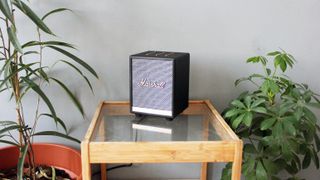
Marshall Uxbridge Voice price and release date
- Available to buy now worldwide
- Costs $199.99 / £169.99 / AU$345
- More expensive than Sonos One
The Marshall Uxbridge Voice speaker was released on April 8, 2020, priced at $199.99 / £169.99 / AU$345.
That might sound expensive for a small wireless speaker, but it’s in line with the rest of Marshall’s guitar amp-inspired smart speakers, which typically sit at the higher end of the price scale.
For comparison, our favorite smart speaker, the Sonos One, is cheaper at $179 / £179 / AU$299 – so for the Marshall Uxbridge Voice to snag the top spot of the best smart speakers of 2020, it would have to sound flawless.

Design
- Guitar amp-inspired design
- Compact build
- Not portable
In true Marshall style, the Uxbridge Voice takes inspiration from the classic brand’s long history of making guitar amps, with a woven grille, black enclosure, and stylish rose-gold accents.
Marshall calls the Uxbridge Voice “the compact sonic powerhouse” – and it certainly delivers on that first promise. Ever seen a mini practice guitar amp? It’s about the same size and weight as one of those, standing just over six inches tall on four rubber feet and weighing about 3lbs.
It doesn’t feel flimsy, which sometimes is the case with lighter speakers, although the plastic enclosure does feel a little cheap – we’d be interested to see whether the Uxbridge Voice looked better with the leather-effect enclosures sported by the Marshall Stanmore II, Woburn II, and Tufton speakers.
You may expect, with such a carry-able frame, that the Uxbridge Voice is a portable speaker, designed for taking out on the road – not so. This wireless speaker relies on the power grid, so must remain firmly attached to a plug socket at all times. It’s a shame that Marshall hasn’t taken advantage of that portable build as it did with the Stockwell II – although, if you’re short on space, a mains-powered speaker with a smaller footprint could be very appealing indeed.

The famous Marshall script logo sits front-and-center of the grille in that metallic rose-gold finish, while a row of blue LEDs adorn the bottom of the speaker – these LEDs light up when you speak to Alexa and give you a visual indication of your volume levels.
On the top of the speaker you’ll find a row of three (aptly-named) rocker buttons, which allow you to adjust the volume, bass, and treble levels of your music. We loved how tactile these buttons feel, and the simplicity of their design.
On either side of these, there’s a play/pause button and a microphone button for when you want to summon Alexa manually.
Unusually, the Bluetooth pairing button is hidden away at the back of the speaker, just above the power port.
Overall, the Marshall Uxbridge looks really attractive, and would look great in any home. Even if you’re not super keen on the rocker aesthetic, the color palette is muted enough for the Uxbridge to maintain a level of chicness that belies its grunge heritage.

Audio performance
- Loud for its size
- Audio is lacking richness
- Customizable EQ
With a woofer and tweeter powered by a 30W Class D amplifier, the Marshall Uxbridge Voice delivers a powerful sound that belies its small size, reaching pretty impressive levels of volume.
The overall soundstage is less impressive however; it’s not particularly wide or spacious, and there’s a distinct lack of dexterity as you listen to tracks with dramatic dynamic changes.
Listening to Alt J’s Left Hand Free, we noticed that the mid frequencies were lacking in richness, while the bass didn’t feel hefty enough to support those twangy guitar riffs and deft vocal lines.
It’s the same story with Little Simz’ No Offense. The sweeping strings and cartoon-style sound effects seemed to be lost amongst the bass lines and chopped beats, which is a real shame; these are the most luscious and enjoyable parts of the track save for Simz’ flowing vocal delivery.
Stupid Things by Girl Ray fares better in the mid range, with full piano chords and flourishing guitar chords underpinned by wandering bass lines. The vocals sound smooth, and solo guitar melodies are suitably prominent in the mix.
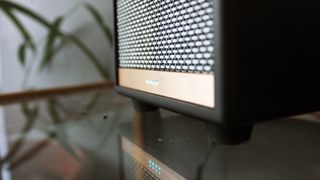
As we moved on to Michael Kiwanuka’s You Ain’t The Problem, we were disappointed to find the backing vocals all but drowned out by the guitar. As Kiwanuka begins to sing his vocals are thankfully far louder, but the backing vocals and other mid-range frequencies suffer throughout the rest of the track.
This issue can be alleviated somewhat by adjusting the equalizer settings via the Marshall Voice app, which offers a number of presets based on musical genres, including Rock, Metal, Pop, Hip-Hop, Electronic, and Jazz, as well as Flat, which offers a totally flat frequency balance (as you may have guessed). To our ears, there’s not a huge amount of difference between these presets, however, but it’s nice to have the option there.
In short, the Marshall Uxbridge Voice is fine for casual listening, but if you’re hoping to hear previously unheard details in your favorite songs, or if you’re looking for audiophile-grade sound quality, you’ll want to look elsewhere.
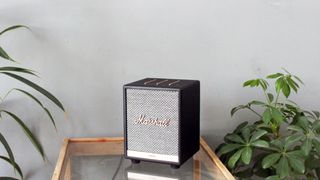
Wireless connectivity
- Wi-Fi and Bluetooth 4.2
- Apple AirPlay 2
- Spotify Connect
Connecting to the Marshall Uxbridge Voice is seamless, particularly if you set it up on your home Wi-Fi network.
The Uxbridge Voice also supports Bluetooth 4.2 – not the most recent version of the wireless transmission standard, but it does the job, and we didn’t experience any annoying connection dropouts in the time we spent testing it. Other methods of connectivity include Apple AirPlay 2 and Spotify Connect .
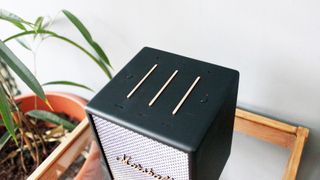
Voice assistant
- Amazon Alexa built-in
- Good microphones
- Smart home-friendly
This wireless speaker comes with Amazon Alexa built-in, which means you can ask it questions, adjust your music playback hands-free, and control your smart home devices.
One of the benefits of Alexa-enabled devices is that Alexa is constantly getting better, and more and more Alexa skills are being added all the time.
Most Skills need to be downloaded, just like apps – for example, to get Alexa to turn on your Philips Hue lights, you'll need the Philips Hue Skill.
A dual microphone array with acoustic noise cancellation is built into the Uxbridge Voice to pick up your commands; even with music playing fairly loudly, these microphones were able to pick up our voice easily.
Should I buy the Marshall Uxbridge Voice?
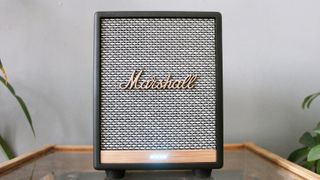
Buy it if...
You love the rock aesthetic
The Marshall Uxbridge Voice looks undeniably cool, with tons of rock heritage to fall back upon. It’s microphone-like grille, amp-style build, and black/rose gold color scheme makes it look authentically musical as well as stylish.
You’re short on space
This speaker’s compact build lends itself to tight spaces, and you could easily work into that awkward nook in your kitchen, living room, or bedroom.
You have Alexa-compatible devices
As an Alexa-powered smart speaker, you can use the Marshall Uxbridge Voice to control your entire smart home. Make sure your devices work with Alexa, otherwise you’ll find yourself stuck with a voice assistant that can’t do much around your home.
Don't buy it if...
You’re an audiophile
The audio quality just isn’t high enough for us to recommend this speaker to hardcore audiophiles – instead, you’d be better off looking at the Sonos One, which offers a stellar soundstage at a slightly lower price.
You need a portable speaker
The Uxbridge Voice relies on the power grid to work, so you can’t take it on the road with you – or anywhere away from a power outlet. For speakers you can take outside, check out the <a href="https://www.techradar.com/news/audio/portable-audio/10-best-portable-speakers-1069079" data-link-merchant="techradar.com"">best Bluetooth speakers of 2020.
You don’t want a voice assistant
Don’t like the idea of Alexa listening into you? This isn’t the speaker for you. Check out the <a href="https://www.techradar.com/reviews/jbl-flip-5" data-link-merchant="techradar.com"">JBL Flip 5, a fun, no-frills speaker that does away with smart features in favour of great sound.
- Looking for more? Check out the best wireless speakers of 2020
Olivia was previously TechRadar's Senior Editor - Home Entertainment, covering everything from headphones to TVs. Based in London, she's a popular music graduate who worked in the music industry before finding her calling in journalism. She's previously been interviewed on BBC Radio 5 Live on the subject of multi-room audio, chaired panel discussions on diversity in music festival lineups, and her bylines include T3, Stereoboard, What to Watch, Top Ten Reviews, Creative Bloq, and Croco Magazine. Olivia now has a career in PR.


